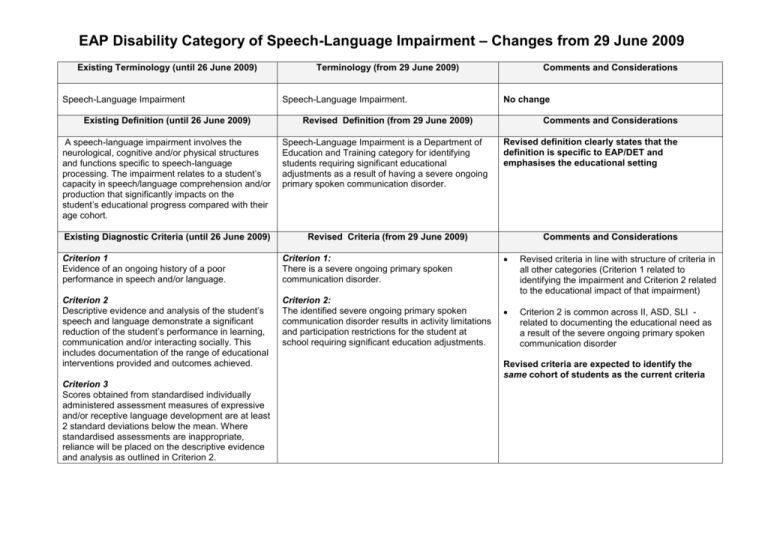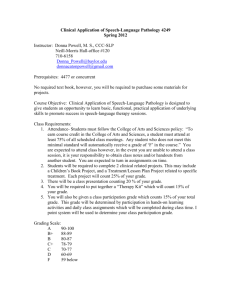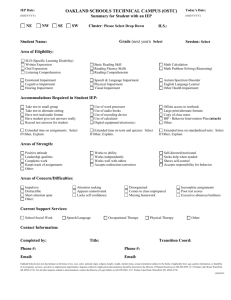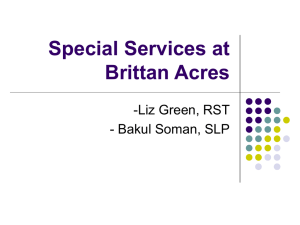Comparison of Current Diagnostic Criteria with Proposed Criteria
advertisement

EAP Disability Category of Speech-Language Impairment – Changes from 29 June 2009 Existing Terminology (until 26 June 2009) Speech-Language Impairment Terminology (from 29 June 2009) Speech-Language Impairment. Existing Definition (until 26 June 2009) Revised Definition (from 29 June 2009) A speech-language impairment involves the neurological, cognitive and/or physical structures and functions specific to speech-language processing. The impairment relates to a student’s capacity in speech/language comprehension and/or production that significantly impacts on the student’s educational progress compared with their age cohort. Speech-Language Impairment is a Department of Education and Training category for identifying students requiring significant educational adjustments as a result of having a severe ongoing primary spoken communication disorder. Existing Diagnostic Criteria (until 26 June 2009) Revised Criteria (from 29 June 2009) Criterion 1 Evidence of an ongoing history of a poor performance in speech and/or language. Criterion 1: There is a severe ongoing primary spoken communication disorder. Criterion 2 Descriptive evidence and analysis of the student’s speech and language demonstrate a significant reduction of the student’s performance in learning, communication and/or interacting socially. This includes documentation of the range of educational interventions provided and outcomes achieved. Criterion 2: The identified severe ongoing primary spoken communication disorder results in activity limitations and participation restrictions for the student at school requiring significant education adjustments. Criterion 3 Scores obtained from standardised individually administered assessment measures of expressive and/or receptive language development are at least 2 standard deviations below the mean. Where standardised assessments are inappropriate, reliance will be placed on the descriptive evidence and analysis as outlined in Criterion 2. Comments and Considerations No change Comments and Considerations Revised definition clearly states that the definition is specific to EAP/DET and emphasises the educational setting Comments and Considerations Revised criteria in line with structure of criteria in all other categories (Criterion 1 related to identifying the impairment and Criterion 2 related to the educational impact of that impairment) Criterion 2 is common across II, ASD, SLI related to documenting the educational need as a result of the severe ongoing primary spoken communication disorder Revised criteria are expected to identify the same cohort of students as the current criteria EAP Disability Category of Speech-Language Impairment – Changes from 29 June 2009 Criterion 4 The student’s educational functioning cannot be accounted for by: -Cognitive ability -Socio-cultural factors -Hearing Impairment -Autism spectrum disorder -Social/emotional factors -Intellectual Impairment -Physical Impairment -Vision Impairment Existing Forms (until 26 June 2009) Revised Forms (from 29 June 2009) EAP VER 07 Speech-Language Impairment Verification Form EAP VER 7 Speech-Language Impairment Verification Form Current form consists of: The format of the revised form is the same as the current but the following have been addressed: PART A: Student Details (common for all categories) Clearer documentation of evidence related to the spoken communication disorder (especially related to demonstrating the primary nature) Common format for evidence related to criterion 2 (the educational impact of the spoken communication disorder) The sections in Criterion 1 linked directly with the evidence required to meet the criterion PART B: Evidence Supporting Verification PART C: Principal Request for Verification (common for all categories) Comments and Considerations Revised form is more explicit in what evidence is required and will assist school teams to document this evidence more clearly SA-SLT/SLPIC and SGO continue to be involved in Profession Specific Quality Assurance and Decision Making








